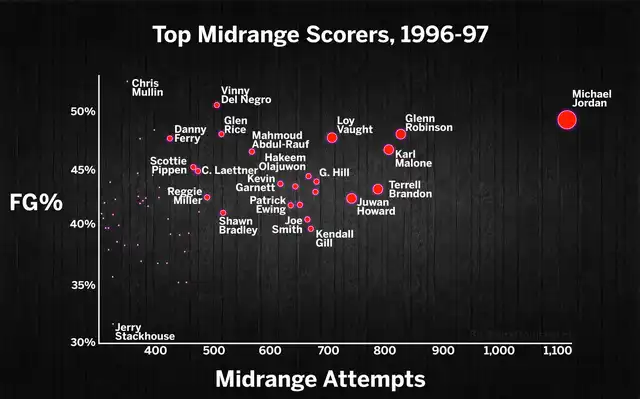Alright, so the other day I got this thought stuck in my head: Michael Jordan’s midrange percentage. We all know the man was a killer from there, right? That pull-up J, the fadeaway – iconic. But I started wondering, what were the actual numbers? Like, could I find a definitive percentage for his midrange game? And that, my friends, is where my little adventure began.

My Initial Digging
First thing I did, naturally, was to hop online and see what I could find. You type it in, and boom, a whole bunch of articles, forum discussions, people throwing numbers around. But here’s the thing I noticed pretty quickly: there wasn’t one single, universally agreed-upon number staring me in the face. It wasn’t like looking up, say, a player’s free throw percentage today. This was murkier.
I realized that “midrange” itself isn’t always defined the same way. Is it 10 to 16 feet? Is it out to the three-point line but not including threes? Different folks, different shot charts, different interpretations. That was the first hurdle.
Trying to Get to the Bottom of It
So, I thought, okay, let’s try to be a bit more systematic. My “practice” here was really about trying to understand how this stuff was even tracked back in MJ’s prime, the 80s and 90s. We’re spoiled now with super detailed shot data for current players. Back then? Not so much. They had field goals made, field goals attempted, three-pointers. But a dedicated, consistently tracked “midrange” category in official box scores? That seemed to be the tricky part.
I started thinking about how they’d even calculate it reliably without the kind of technology we have now. You’d probably have to go back and manually chart games, or rely on basketball statisticians who were doing that kind of detailed work, which wasn’t as widespread or standardized.
It’s funny, I did come across some specific stats, like I remember reading that in the ’95-’96 season, Jordan shot something like 40.0 percent from three-point range. Pretty impressive for him, actually. And then you hear whispers about how even other stats from that era, say, some defensive metrics for MJ that same year, had people pointing out inconsistencies. It just made me realize that getting super precise, granular data for something like “midrange percentage” from back then is a whole different ball game than it is today. It’s not like pulling up a player’s shot chart on a website in two clicks.

What I Reckon After All This
So, after spending a fair bit of time trying to nail down that elusive, single “Michael Jordan midrange percentage,” I came to a realization. It’s tough. Really tough to find one number that everyone agrees on, especially for his entire career or even consistently for specific seasons in a way that’s easily digestible like modern stats.
Here’s what I think happened:
- The definition of “midrange” varied.
- Detailed public shot tracking wasn’t as sophisticated or accessible.
- A lot of the older analysis focused on overall field goal percentage, and everyone just knew a huge chunk of MJ’s damage came from that midrange area through the eye test.
Honestly, my little practice session here showed me that while we crave precise numbers for everything, sometimes the legend and what we all witnessed holds more weight, or at least, it’s harder to quantify with a single, simple stat from that time. We all saw him dominate from there. The eye test was undeniable. He’d pull up on a dime, rise, and it was cash. Over and over again.
So, do I have a definitive percentage for you? Not a clean, simple one. But my process of trying to find it definitely reminded me of how much the game, and the stats around it, have evolved. And it also reminded me that MJ’s midrange game was just pure art, numbers or not. You just knew it was going in. And for a guy like Jordan, maybe that feeling, that certainty, is just as important as any percentage point.
